I first learned how to plant eggplants a few years ago, when I got some leftover seedlings and general instructions from an attendant at a plant nursery.
Since then, I’ve planted several types in the garden, with varying results, based on the conditions at different times of the year.
Surprisingly, Eggplant is easy to grow in the ground and containers, provided you take some time to prepare the area correctly.
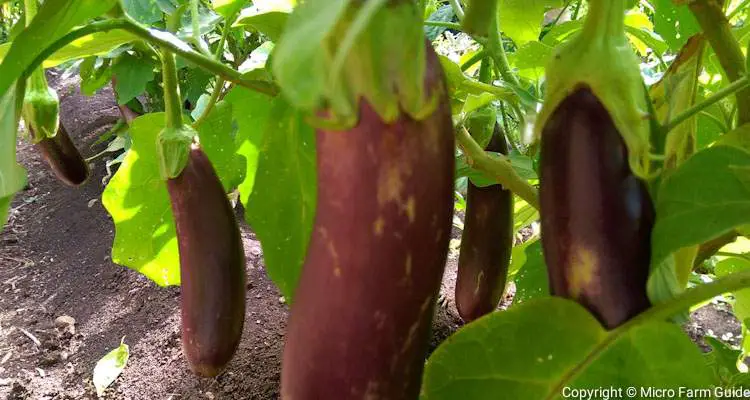
Yet, it can be challenging based on your climate and soil type, due to its sensitivity to cold weather and moisture.
In this article, you will learn how to grow eggplants from seeds at home and some tips I use to increase fruit production throughout the growing season.
How Big Do Eggplant Plants Get?
Before we get started, I must point out that Eggplants can grow up to 4 feet tall with a span of over 3 feet wide.
They are warm-weather plants that can grow as a perennial in warm climates but grow annually in most areas.
You will need to keep this in mind when choosing a suitable location, since their size and thorny leaves can make the area impassible.
However, it is possible to manage the size and shape of the plant with a little practice. Let’s dig in!
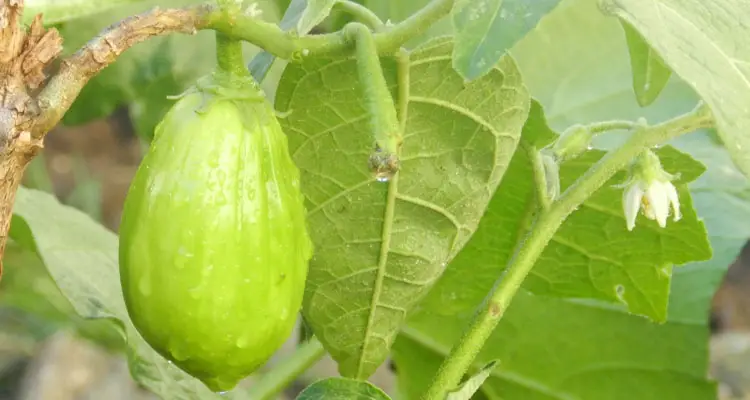
1. Choose Suitable Eggplant Varieties
There are several varieties of eggplants to choose from, available in different colors, shapes, and sizes.
Choose a variety that suits your needs and the growing conditions you can provide.
Usually, purple varieties such as Zebra are recommended for beginners. However, you can also try Fairy Tale, While, and Japanese Eggplants for home use.
Usually, we grow whatever is available at the agriculture centers, since they are chosen for our tropical climate.
2. Sow Eggplant Seeds Indoors
You can sow eggplant seeds directly in the ground, provided the soil temperature is at least 70°F.
However, since eggplants can take up to 120 days to reach maturity, it is recommended to sow them indoors to get a headstart on the growing season.

- Fill a seedling tray with a quality potting mix, then sow two seeds per cell about ¼ inch deep.
- Cover the seeds with a thin layer of potting mix and water carefully. It is best to use “fresh” seeds, so look at the package for use by date.
- Eggplant seeds are easy to germinate but can take up to 14 days, so be patient and keep the mix moist.
- Place a piece of cardboard on the tray and place it in a warm dark place until they emerge.
It would help if you soaked eggplant seeds overnight or used the tissue technique to pre-germinate them.
3. Prepare The Growing Area
Eggplants are sun-loving crops that grow best in moist, fertile, well-drained soils.
- As a result, you should choose an area that receives at least 6 hours of sun per day and where the soil drains well.
- Remove vegetation such as weeds, then amend the soil with compost, worm casting, or other organic fertilizer.
- Spread organic materials as mulch onto the surface of the soil. Water thoroughly and cover with a tarp or other material until you are ready to plant.
4. Transplant Seedlings
You can transplant eggplants once the soil temperature is at least 60 ºF. However, I prefer waiting until it is at least 70 ºF to be safe.
- Harden the seedlings a week before transplanting by placing them outside, gradually extending the time they are exposed to the weather.
- Plant seedlings into the soil, spacing them 18 to 36 inches apart, burying the root ball and stem up to the first set of lower leaves.
- Spread a layer of much around the base of the plant, then water thoroughly.
Eggplants can grow large in the right conditions, so be ready to prune and stake them when necessary.
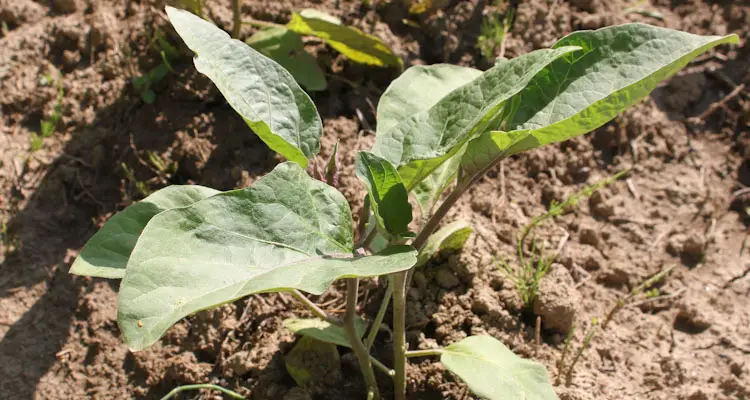
5. Water And Fertilize
Eggplant is a member of the Solanaceae family, commonly referred to as Nightshade, which includes plants such as tomatoes and peppers.
So it should be no surprise that they have similar needs and can use similar fertilizers.
For example, you can use a general fertilizer in the early stages of growth. Still, as the plant starts to flower, you can use a fertilizer formulated for tomatoes or peppers.
Likewise, it would be best if you watered plants regularly to ensure that the soil remains cool and moist, especially during dry spells and excessively high temperatures.
Some people recommend adding Epsom salt around plants since eggplants require a lot of magnesium. However, this is only necessary when growing plants in pots.
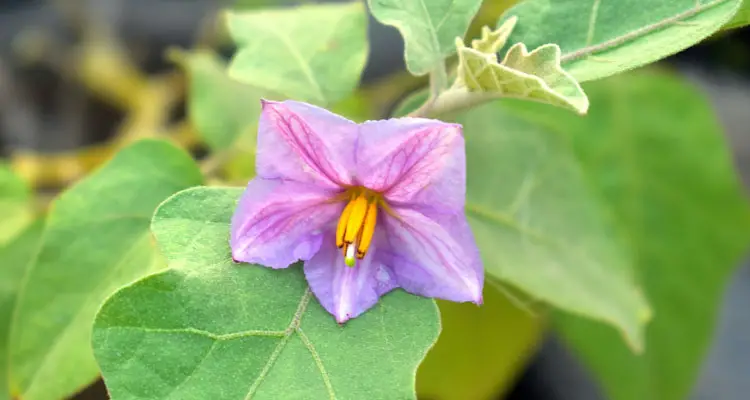
6. Prune To Allow Airflow
Eggplants can grow pretty large, with tangled branches and large leaves. These tend to restrict airflow and create the perfect habitat for specific pests.
Prune branches, forming a “Y” with the main stem. Remove overlapping and inward-pointing leaves if they cross the center stem.
Remove dead and dying leaves, especially the lower ones, to allow the free flow of air and easy access to the fruit.
Trim the branches and large leaves of the plant at the end of the growing season to encourage new vegetation growth.
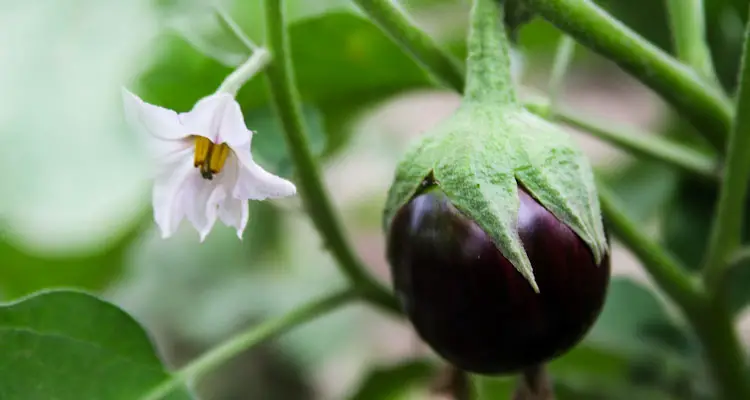
7. Harvest When Fruits Are Immature
Eggplants produce fruit about 4 to 8 weeks after they flower, depending on the variety and conditions under which they are grown.
They should be harvested often, once the fruit reaches its full size, but before it matures. This will encourage additional fruit production.
You can harvest eggplant seeds at the end of the growing season by allowing the fruit to ripen on the plant. However, you will have to wait until the fruit becomes soft with a golden brown color.
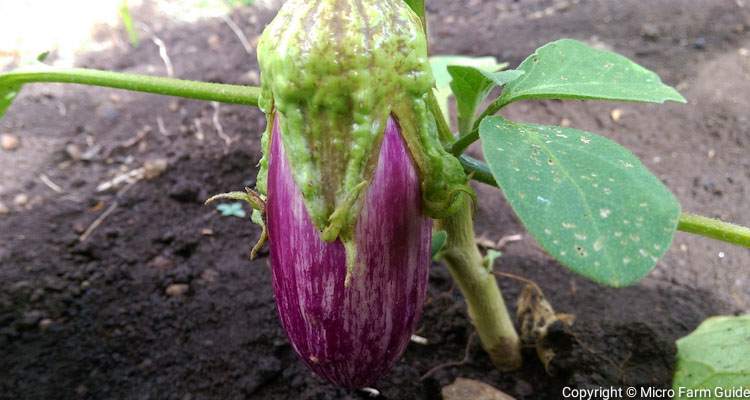
How To Grow Eggplants In Pots (Simple Guide)
Eggplants are well suited to grow in pots, provided they receive enough nutrients, moisture, and sunlight.
The potting mix should be well drained and amended with compost or other nutrient-rich materials.
Eggplants can grow large and produce better fruits when their roots grow freely.
As a result, you should choose pots that are at least 12 inches wide and deep. However, it would be best to consider larger pots for better results.
Transplant 1 eggplant seedling into the container burying its stem to the first set of leaves.
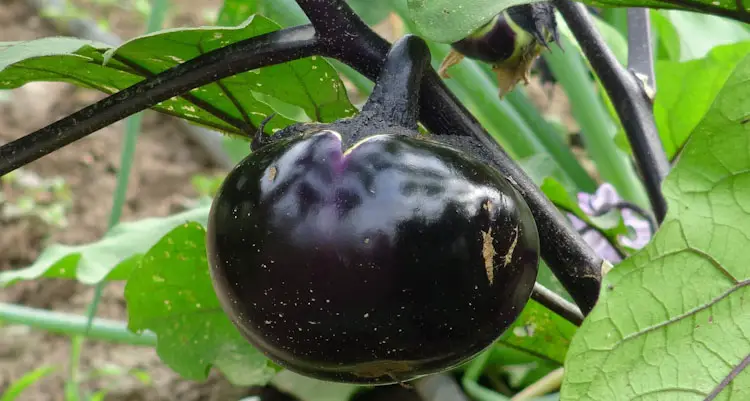
You can plant 2 eggplants together, provided the pot is large enough to be spaced at least 12 inches apart.
Yet still, you do not need 2 eggplants to produce fruits. However, you will need to assist with pollination through the use of a cotton swabs or other vibrating toothbrush.
Water your eggplants thoroughly, ensuring the potting mix remains moist as they grow.
Apply a soluble vegetable fertilizer weekly, but switch to a tomato or pepper fertilizer once the plant starts to produce flowers.
Monitor your plants, pruning the lower leaves when necessary to allow free air flow and access to harvest fruits.
Related Questions
Should Eggplant Be Planted Deep?
Eggplants should be planted as deep as possible to encourage root development along the stems, similar to other members of the nightshade family.
Do Eggplants Need Epsom Salt?
Eggplants do not need Epsom Salt if grown in well-prepared soil since it is naturally available in the ground. However, it is a great source of magnesium, especially for plants grown in containers or extreme conditions.
Should I Pinch Off Eggplant Flowers?
You should pinch off the first set of flowers to encourage the plant to develop stronger stems and roots. This will ensure that the plant is better prepared for fruit production.
How Do I Get My Eggplant To Produce More Fruit?
The easiest way to get eggplants to produce more fruit is to provide suitable growing conditions in the early stages of growth and hand pollinate them to ensure optimal fruit production.
How Long Does It Take Eggplant To Grow From Seed?
Eggplants take up to 120 days to grow from seed to harvest, depending on the variety and climate in which it is grown.

